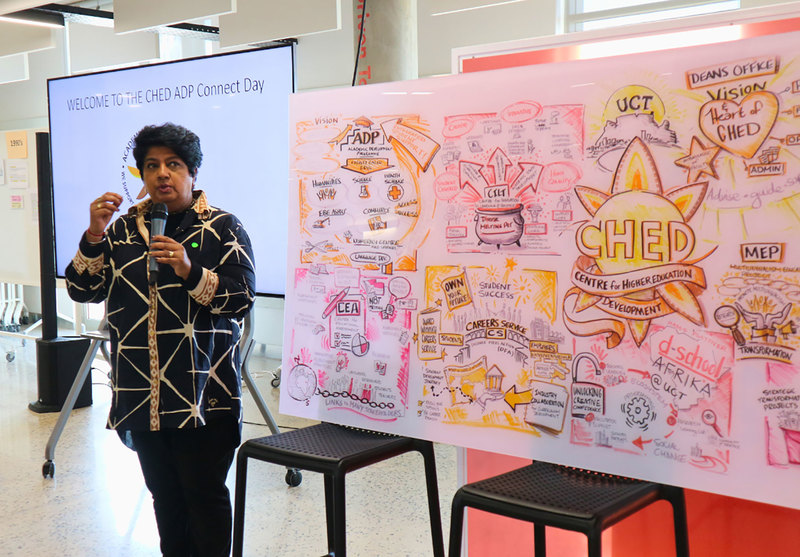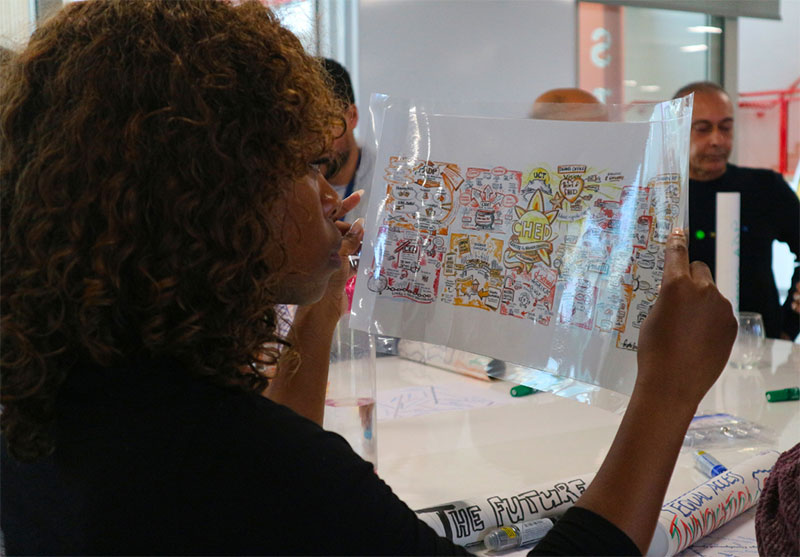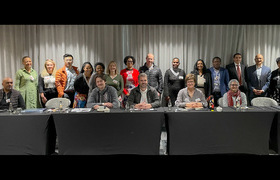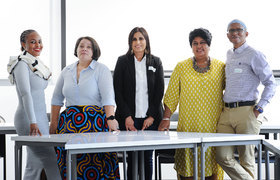Exploring the multifaceted work of higher education development
19 October 2023 | Story Deidre Schippers. Photos Supplied. Read time 4 min.
The Centre for Higher Education Development (CHED) at the University of Cape Town (UCT) unveiled a “graphic harvest” artefact during Connect Day, a quarterly gathering where different units in CHED showcase their work.
The event was held at the Hasso Plattner School of Design Thinking Afrika (d-school Afrika) on 1 September, following a process called “graphic harvesting”, which CHED embarked on in June. Units within the department were given the opportunity to reflect and examine their practice in relation to the mission, goals and purpose, as well as how CHED drives and fits into the UCT academic project.
Through a series of prompts, staff were given the space to creatively reflect on their identity, purpose, core work, and how their work connects to CHED, UCT, as well as how it responds to national and global contexts. Departmental representatives then presented their reflections to the deanery and heads of department, during Connect Day last month.
Sketched in real-time while units presented their work, this provided a reflective snapshot of how they understood their identity, purpose and vision.

Reflections
During her remarks on the day, the dean of CHED, Associate Professor Kasturi Behari Leak, noted: “If you look at it, it’s not only about what the words say. It must do something for us at a higher level, an abstracted level, for you to, at any one moment, be able to abstract, take out of this, what the purpose of CHED is. How does CHED fit into the UCT academic project? What is CHED’s mission and its goals?”
Associate Professor Behari-Leak added: “If you see the word ‘access’ or ‘success’ repeated in each of these units, what does it tell us? If you see ‘social justice’ if you see, ‘language’. So, it shows us where we are trying to head and what we want to hold up as dear in terms of our work going forward. So, that’s the kind of motivation [and] rationale.”
“We can see where we are overlapping; where we are intersecting; where we are different.”
CHED deputy deans and directors were also given an opportunity to share their thoughts.
Associate Professor Dale Taylor, the deputy dean for Teaching, Learning and Research, remarked: “[It shows] how all the different bits of CHED contribute to the academic journey, towards Vision 2030.”
Dr Gideon Nomdo, the deputy dean for Transformation in CHED, said: “We can see where we are overlapping; where we are intersecting; where we are different. And those differences are important because I think it provides quite a unique character to CHED as a faculty and to the types of work that we do.”
Richard Perez, the director of the d-school Afrika, noted: “The sort of DNA of CHED is the fact that it just collaborates. It is always out there speaking. We don’t work in a silo just amongst ourselves. And so, our strength is how we look out, and often not sort of how we look in at each other … a key component of CHED is that we are the innovators in the university. We innovate in the future of education in many different ways.”
Sukaina Walji, the director of the Centre for Innovation in Learning and Teaching (CILT), also weighed in: “It’s a reminder that we can be more than the sum of our parts … I’ve always felt that maybe at the sub-level that we’ve only been able to do quite, you know … good things, impressive things because [of] the collaboration … somehow you can achieve something that seems really impossible at that moment because of the people and the collaborative approach.”
Visit CHED’s website for more information on the different units and departments.
 This work is licensed under a Creative Commons Attribution-NoDerivatives 4.0 International License.
This work is licensed under a Creative Commons Attribution-NoDerivatives 4.0 International License.
Please view the republishing articles page for more information.










